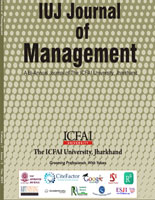(Nimisha Sinha )
Keywords : Digital Transformation, Entrepreneurship
EOI : eoi.citefactor.org/11.11224/IUJ.11.01.01



 The IUJ Journal of Management (IUJ-JOM) is the flagship journal of ICFAI University Jharkhand, Ranchi.
The aim of the journal is to provide insight into the business and management research. It also creates
a platform for the researchers, academicians, professors, practicing management professionals and proponents
in disseminating original,
The IUJ Journal of Management (IUJ-JOM) is the flagship journal of ICFAI University Jharkhand, Ranchi.
The aim of the journal is to provide insight into the business and management research. It also creates
a platform for the researchers, academicians, professors, practicing management professionals and proponents
in disseminating original,
theoretical and applied research in the field of management and allied disciplines. The Journal is a Bi-Annual, . . . . .Read more.
 Decision-making is as old as Civilization with Economics being the fulcrum. In a way, undisputedly, economic decision-making represents the evolution and revolution of Economics as an accepted extension of Science.Economic decision-making is critical in the sense that a correct tactic needs to be adopted to make a balance between economics as a science and also an offshoot of interdisciplinary scholarship in the 21st Century. The foundation of stimulus has been neuro-economic decision explorations (merger of philosophies from cognitive science and management.
Read more.
Decision-making is as old as Civilization with Economics being the fulcrum. In a way, undisputedly, economic decision-making represents the evolution and revolution of Economics as an accepted extension of Science.Economic decision-making is critical in the sense that a correct tactic needs to be adopted to make a balance between economics as a science and also an offshoot of interdisciplinary scholarship in the 21st Century. The foundation of stimulus has been neuro-economic decision explorations (merger of philosophies from cognitive science and management.
Read more.
 In recent years, digital finance has become a widely discussed public policy due to the innovative nature of new technology. The financial industry, like other industries, typically adopts new and upgraded technology to make tasks more efficient. Digital finance is an example of such technology that is currently in demand.
Read more.
In recent years, digital finance has become a widely discussed public policy due to the innovative nature of new technology. The financial industry, like other industries, typically adopts new and upgraded technology to make tasks more efficient. Digital finance is an example of such technology that is currently in demand.
Read more.
 "Artificial Intelligence (AI) relates to the ability of computers to handle complex situations around us through advanced complex solving approach. It is used in everyday work of life. We can see its application in as robotic vacuum cleaners or running shoes in consumer durable.
Read more.
"Artificial Intelligence (AI) relates to the ability of computers to handle complex situations around us through advanced complex solving approach. It is used in everyday work of life. We can see its application in as robotic vacuum cleaners or running shoes in consumer durable.
Read more.
Subscribe now to get notified about IU Jharkhand journal updates!
(Nimisha Sinha )
Keywords : Digital Transformation, Entrepreneurship
EOI : eoi.citefactor.org/11.11224/IUJ.11.01.01
( Col Dr J Satpathy, Dr Lipsa Mishra )
Keywords : Neuro-Economics, Decision, EEG, Alpha Waves, SVG, Neuro-Trajectory and Neuronal Shifts.
EOI : EOI: eoi.citefactor.org/11.11224/IUJ.11.01.02
( Dr. Ashish Mohan, Neha Kumari )
Keywords : Digital Finance, Financial inclusion, Digital Technology, Digital Channels
EOI : eoi.citefactor.org/11.11224/IUJ.11.01.03
( Jyoti Shree Attal, Dr. Reshma Shrivastava )
Keywords : HR analytics, PerformanceManagementSystem,Industry5.0, coal mining sector
EOI : eoi.citefactor.org/11.11224/IUJ.11.01.04
( Sumit Mishra, Dr. Bhagabat Barik )
Keywords : Internet users, Online shopping, Online shopping behaviour, Palamu.
EOI : eoi.citefactor.org/11.11224/IUJ.11.01.05
( Anjan Niyogi, Dr. Pallavi Kumari )
Keywords : Artificial Intelligence (AI), Hearing Aid, Digital Sound Processing (DSP), Machine Learning (ML), Deep Learning (DL), Neural Network
EOI : eoi.citefactor.org/11.11224/IUJ.11.01.06
( Soumyajyoti Bhattacharjee )
Keywords : Logistics, Green Logistics, Digitalization, Supply chain, IOT in Logistics, Blockchain, Logistics 4.0
EOI : eoi.citefactor.org/11.11224/IUJ.11.01.07
( Shalini, Dr. Sandeep Kumar )
Keywords : Sustainable work force, employee engagement, well being,
EOI : eoi.citefactor.org/11.11224/IUJ.11.01.08
( Abhinav Bakshi, Bishnu Charan Parida )
Keywords : Women SHGs, Community Institutions, Financial Inclusion, Internet, Mobile Technology, Digital Literacy
EOI : eoi.citefactor.org/11.11224/IUJ.11.01.09
( Dr Lipsa Misra )
Keywords : Neuromarketing; Neuroscience; Product sale; Advertising; Bibliometric Analysis; Scopus database; Social media ; Consumer behavior
EOI : eoi.citefactor.org/11.11224/IUJ.11.01.10
( Gurudutt, Nishu Kumar )
Keywords : Health Care, Digital Transformation, Technology, Telemedicine, Marginalized People.
EOI : eoi.citefactor.org/11.11224/IUJ.11.01.11
( Shakeel Ahmed )
Keywords : business, governance , sustainability firm’s performance.
EOI : eoi.citefactor.org/11.11224/IUJ.11.01.12
( Manish Kumar, Dr Manish Kumar )
Keywords : Social Media Use (SMU), Disruptive Technology, consumer behaviour, Rural marketing
EOI : eoi.citefactor.org/11.11224/IUJ.11.01.13
( Bishnu Charan Parida )
Keywords : Emotional Intelligence, Workplace, Behavioural Change, Adaptability
EOI : eoi.citefactor.org/11.11224/IUJ.11.01.14
( ShivaniWadhwa, Yashvi Grover )
Keywords : Marketing, Digital Transformation, Marketing Strategies, Corporations, Marketing Agencies
EOI : eoi.citefactor.org/11.11224/IUJ.11.01.15
( Prashant Kumar Thakur )
Keywords : Real estate, employment generator, household income, demand
EOI : eoi.citefactor.org/11.11224/IUJ.11.01.16
( Suvra Das )
Keywords : Consumer behaviour. consumer attitudes. consumer perceptions. consumer culture. Online shopping, online consumer behaviour model, technology, e-commerce
EOI : eoi.citefactor.org/11.11224/IUJ.11.01.17
( Dr.Akinchan Buddhodev Sinha )
Keywords : Genesis of CSR; Social and Relationship Capital Scenario; Gauging Sustainability.
EOI : eoi.citefactor.org/11.11224/IUJ.11.01.18
( Divya Chirayath )
Keywords : Agricultural value chain, Notified Area Committees, Agrarian woes, Food security, Landholding, Intervention, Marginal farmers, Green revolution
EOI : eoi.citefactor.org/11.11224/IUJ.11.01.19
